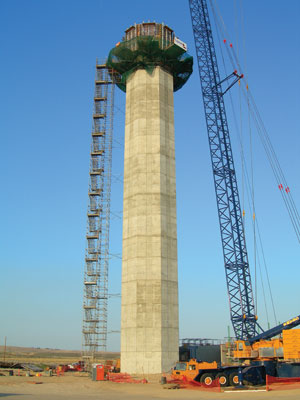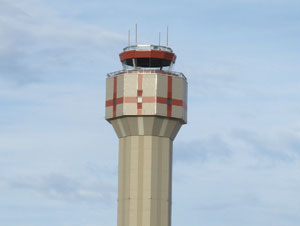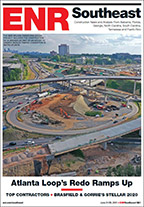The new 290-ft Boise Airport Air Traffic Control Tower is not only a highly visible landmark in Treasure Valley, it’s also the tallest building in Idaho.


The $13-million tower controls sky traffic within a 5-mile radius of the airport and up to 30,000 ft above it. It will serve approximately 180,000 takeoffs and landings a year, says Gordon Stewart, the control tower manager.
Located south of the current tower and east of the Idaho National Guard base, the completed facility was turned over to the Federal Aviation Administration to install instruments and equipment on Oct. 16. Commissioning of the tower is scheduled for January 2011.
Layton Construction’s Boise office served as the general contractor on the tower, and BPA Architects of Vancouver British Columbia designed it. Gabe Beal, Layton project manager, says that because the project was for the FAA, the owner’s contract was a couple of thousand pages long.
The FAA says that when the agreement to build the new tower was signed in 2006, the airport served more than 3.2 million passengers. Steward adds that since then, airport traffic in Boise increased, then decreased to 3.1 million, due to the economic downturn.
The current facility was built to meet user levels of 4.5-million annual passengers, which is projected to occur by 2016, according to Patti Miller, Boise Airport marketing and air service spokesperson.
Sight Lines
“We have visibility challenges, partly created by the new terminal building and the growth of the airport and the community,” says Stewart.
The new control tower will alleviate some of the existing visibility problems. “There are viewing issues with the current 35-year-old tower because it is only 65 ft tall,” Stewart says. “Having been in the new tower, I have seen that the perception is completely changed, and it will make it much easier for us to manage air and ground traffic.”
The tower is constructed of cast-in-place concrete and can withstand 95-mph winds. A 550-sq-ft cab at the top seats five air traffic controllers and allows for future growth, Stewart says.
The base building is constructed of vertical concrete masonry units attached to the tower. The control cab sits atop the 13th floor with access to the 11th floor by stairs and an elevator. The floors below the cab are mostly dead space but include mechanical, electrical, plumbing and fire pumps.
The tower’s foundation is a 5-ft-deep mat slab of steel-reinforced concrete. An Atlas jump-form system was used for the first 12 floors of the concrete tower shaft. Interior levels are spaced at 26-ft intervals and constructed of structural steel and concrete slabs on metal decks.
Safety Risks
The tower cab was built with metal studs, DensGlass sheeting and cement panels. All concrete slabs on the metal deck throughout the tower incorporate rebar. Five different cranes were used onsite, the largest with a lift capacity of 440 tons.
Project Team
Owner:
Federal Aviation Administration
General Contractor:
Layton Construction
Design Firm: BPA Architects
Among the Subs: Quality Tile Roofing, Thueson Construction, De Best Plumbing, Lea Electric, YMC Mechanical
Beal says the biggest safety hurdle on the project was going up the full height of the tower. “Anytime you start going vertical, your safety risks multiply,” he says. “Knowing that we were up against that issue, we planned accordingly. We had to select the proper crane for all of hoisting and lifting.”
Beal says the roof was set with one pick. “We assembled the roof and floor of the cab on the ground then used the 440-ton crane to set both,” he adds.
Idaho Gov. C.L. “Butch” Otter says the new tower is important to flight safety in Idaho and the Northwest. “It will provide the ability to see and better control ground and air traffic to the runway on the south side of the airport,” Otter says. “It also will enable us to significantly increase traffic to the Boise Airport in the future – which is great for our economy and our ability to attract new businesses to the area.”



Post a comment to this article
Report Abusive Comment